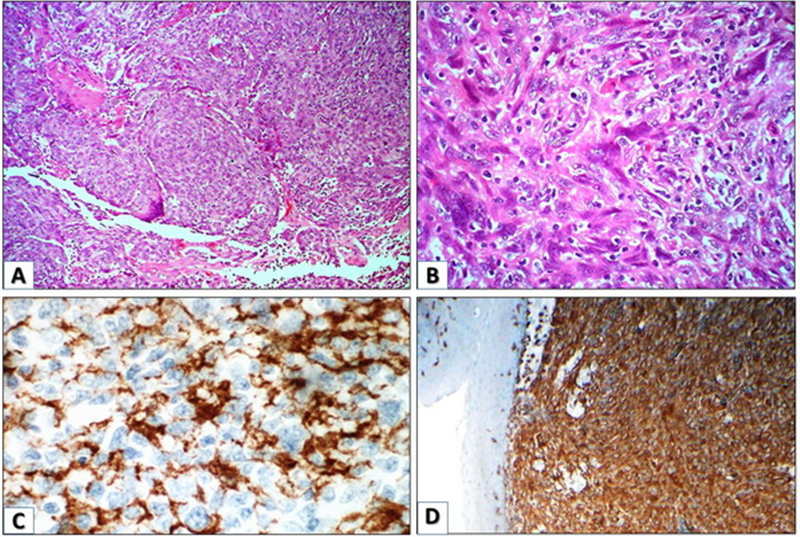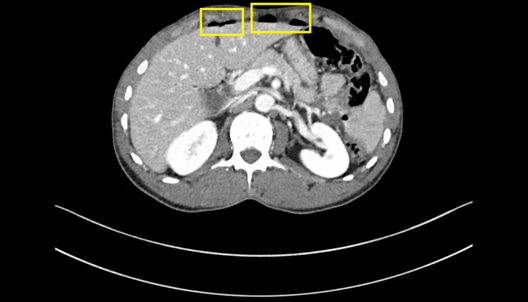 |
Case Report
Sickle cell crisis in third trimester of pregnancy complicated by hemolysis, elevated liver enzymes, and low platelets (HELLP) syndrome
1 Resident, Obstetrics and Gynecology, Penn State Health Milton S. Hershey Medical Center, Hershey, PA, United States of America
2 Fellow, Maternal Fetal Medicine, Penn State Health Milton S. Hershey Medical Center, Hershey, PA, United States of America
3 Assistant Professor, Maternal Fetal Medicine, Penn State Health Milton S. Hershey Medical Center, Hershey, PA, United States of America
Address correspondence to:
Stephen Senthan Rasiah
507 Huxley Drive, Hummelstown, PA 17036,
United States of America
Message to Corresponding Author
Article ID: 100060Z06SR2019
Access full text article on other devices

Access PDF of article on other devices

How to cite this article
Rasiah SS, Maines JL, Condon N. Sickle cell crisis in third trimester of pregnancy complicated by hemolysis, elevated liver enzymes, and low platelets (HELLP) syndrome. Case Rep Int 2019;8:100060Z06SR2019.ABSTRACT
Introduction: Sickle cell disease is one of the most common hemoglobinopathies in the world, affecting approximately 100,000 people annually in the United States alone. This case presents an example of the importance of close monitoring during the pregnancies of patients with sickle cell disease in order to facilitate prompt evaluation and treatment of complications as they arise.
Case Report: A 22-year-old, gravida 2 para 1001, was admitted at 306/7 weeks of gestation due to sickle cell crisis. Following admission and observation, she developed hemolysis, elevated liver enzymes, and low platelets (HELLP) syndrome on hospital day-4, and decision was made to proceed with delivery. The patient was maintained on magnesium seizure prophylaxis for 24 hours following delivery. The patient was discharged home on post-operative day-5 on labetalol 400 mg q8hrs secondary to persistent hypertension. The patient was doing well at her routine six week postpartum visit and maintained on the anti-hypertensive medication.
Conclusion: This case of HELLP syndrome following a sickle cell crisis highlights the importance of close monitoring of sickle cell disease patients during pregnancy. Multi-disciplinary care plays a critical role in the successful management of these patients due to the acute decompensation that can follow a sickle cell pain episode. A facility must be prepared to provide support from obstetrics, hematology, neurology, and intensive care. The obstetrical team must understand sickle cell physiology. The resources to provide prompt blood transfusion and exchange transfusion must also be available. This knowledge is especially important to health care providers who may be taking care of patients in lower resource settings.
Keywords: Elevated liver enzymes, Hemolysis, Low platelets, Pregnancy, Sickle cell
INTRODUCTION
Sickle cell disease is one of the most common hemoglobinopathies in the world affecting approximately 100,000 people annually in the United States alone [1]. Sickle cell disease is associated with increased rates of maternal morbidity and mortality worldwide. These events often involve acute changes in patient’s health status [2]. Hemolysis, elevated liver enzymes, and low platelets (HELLP) syndrome is an obstetric emergency that is diagnosed by the presence of the aforementioned factors. It is thought to be a severe form of preeclampsia. The HELLP syndrome requires prompt maternal stabilization and consideration for delivery [3],[4]. This case presents an example of the importance of close monitoring during the pregnancies of patients with sickle cell disease in order to facilitate prompt evaluation and treatment of complications, such as HELLP syndrome, as they arise.
CASE REPORT
A 22-year-old, gravida 2 para 1001, was admitted at 29 3/7 weeks of gestation as a transfer of care from an outside facility secondary to an acute drop in hemoglobin in the setting of abdominal pain with sickle cell trait and beta thalassemia trait. Hemoglobin had dropped from 9.8 g/dL to 7.7 g/dL. Platelet count was 155x109/L, creatinine was 0.5 mg/dL, ALT 15 units/L, AST 26 units/L; all within normal limits. Urine protein creatinine ratio was 0.22 and a 24 hour urine protein was 186 mg. The patient had been diagnosed with gestational hypertension at 29 weeks gestation, and a work up for preeclampsia returned negative. After the transfer to our facility, the patient was treated with pain medication, her pain improved and she was discharged to home in stable condition.
One week later, at 30 6/7 weeks of gestation, she again presented to the outside hospital with recurrent diffuse body pain and was immediately transferred to our facility. She endorsed worsening back pain, chest pain, and shortness of breath. The pain did not respond to pain medication. She denied leakage of fluid, vaginal bleeding, contractions and cramping. She admitted to positive fetal movement. Upon arrival to our institution, blood pressure was elevated, at 171-197/90-105 mm/ Hg, heart rate was within normal limits at 80–97 beats/ min, and O2 saturation was 98% on room air. Lungs were clear to auscultation with unlabored breathing. Abdomen was soft and nontender. There was no right upper quadrant tenderness. Cervix was closed and thick. Cephalic presentation was noted on bedside ultrasound. Category I fetal tracing was noted with no contractions. Fetal growth was within normal limits by ultrasound. Admission hemoglobin was 6.2 g/dL, creatinine was elevated at 1.24 mg/dL, platelets were low at 131x109/L, ALT was normal at 21 units/L, and AST was elevated at 84 units/L. Urine protein creatinine ratio was elevated at 5.03 and 24 hour urine protein was also elevated at 3.12 grams. Serial labs were completed which showed slight improvement in her hemoglobin following transfusion of one unit of packed RBCs. Creatinine remained elevated >1 mg/dL. Platelets continued to decline reaching a nadir of 105x109/L. Initially, it was determined that the patient was in sickle crisis, and not HELLP syndrome, as only the AST was elevated and not the ALT, the peripheral smear was consistent with thrombotic microangiopathy with maximum of 7–8 schistocytes per high power field, and there was noted to be decreased haptoglobin <10 mg/dL, elevated LDH 1372 units/L, and elevated T Bil 2.7 mg/dL, which would all be consistent with hemolysis.
The patient received a course of betamethasone due to concern for need for preterm delivery. Maintenance fluids of 0.45% NaCl were initiated to prevent further sickling. Pain was managed with IV narcotics. She was started on magnesium seizure prophylaxis secondary to severely elevated blood pressures.
On hospital day 4, she was noted to have acutely worsening blood pressures requiring repeat intravenous antihypertensive medication as well as worsening lab tests. Concern was raised for development of HELLP syndrome, and decision was made to deliver. A primary cesarean section was performed secondary to the patient being remote from delivery in the setting of worsening HELLP syndrome. The patient delivered a viable male infant weighing 1630 grams with APGARs of 8 and 8. Surgery was uncomplicated. Labs were trended following delivery. Platelets reached a nadir of 65x109/L, ALT elevated to 46 units/L and AST elevated to 78 units/L. Creatinine improved to 0.75 mg/dL after delivery. Hemoglobin remained stable at 7.6 g/dL. The patient was maintained on magnesium seizure prophylaxis for 24 hours following delivery secondary to the diagnosis of preeclampsia with severe features and HELLP syndrome. The patient was discharged home on post-operative day-5 on labetalol 400 mg q8hrs secondary to persistent hypertension. The patient was doing well at her routine six week postpartum visit and maintained on the antihypertensive medication.
DISCUSSION
An understanding of the physiology of sickle cell disease in pregnancy is important because pregnancy increases the incidence of sickle cell disease morbidities, including acute pain episodes, infection, vaso-occlusive episodes, anemia as a result of the increased vascular stasis, hypercoagulability, and metabolic requirements of pregnancy [2],[5]. In addition, patients with sickle cell disease, in comparison to patients without sickle cell disease, have an increased incidence of pregnancyrelated complications, including fetal growth restriction, hypertensive diseases of pregnancy, preterm labor and placental abruption [3],[4],[6]. Patient with sickle cell disease are at higher risk for acute pain crises during pregnancy. The treatment for these episodes includes hydration, oxygenation, pain control and blood transfusion.
Evidence suggests that these acute pain crises can sometimes be followed by more catastrophic complications associated with sickle cell disease, such as pulmonary embolism, acute chest syndrome, stroke, and eclampsia, and sometimes it may be difficult to differentiate a pain crisis from worsening complications [7]. These complications play a role in the increased incidence of maternal morbidity and mortality that is seen with sickle cell disease patients in pregnancy [2],[3],[8].
Our case describes the occurrence of HELLP syndrome following an acute pain crisis. The case highlights the importance of multi-disciplinary care in the management of patients with sickle cell disease. The patient initially presented as a transfer of care from a smaller regional hospital secondary to pain. Stabilization of patients with acute pain crisis in pregnancy is important because it helps to separate pain crisis from other potential complications, which include obstetric as well as sicklecell related morbidities. Blood transfusion has been shown to be an important treatment for sickle cell disease and current guidelines suggest the use of transfusion for acute anemia, chest syndrome or stroke [9]. Transfusion was especially helpful in our case due to the onset of HELLP syndrome and the need for expeditious delivery.
There is one other case report in the literature which describes HELLP syndrome and acute chest syndrome in a sickle cell patient who ultimately required blood transfusion and delivery. However, secondary to red blood cell alloimmunization, there was a delay in finding compatible blood. Red cell salvage was attempted, but was unsuccessful due to the underlying hemolysis. Fortunately, she remained stable until blood was available. This case shows the importance of communication with the blood bank to ensure that these patients will have blood available as there is a higher incidence of alloimmunization in this population due to their history of frequent and multiple transfusions [10].
CONCLUSION
Our case of hemolysis elevated liver enzymes and low platelets syndrome following a sickle cell crisis highlights the importance of close monitoring of sickle cell disease patients during pregnancy. Multi-disciplinary care plays a critical role in the successful management of these patients due to the acute decompensation that can follow a sickle cell pain episode. A facility must be prepared to provide support from obstetrics, hematology, neurology, and intensive care. The obstetrical team must understand sickle cell physiology. The resources to provide prompt blood transfusion and exchange transfusion must also be available. This knowledge is especially important to health care providers who may be taking care of patients in lower resource settings.
REFERENCE
1.
Brousseau DC, Panepinto JA, Nimmer M, Hoffmann RG. The number of people with sickle-cell disease in the United States: National and state estimates. Am J Hematol 2010;85(1):77–8. [CrossRef]
[Pubmed]

2.
Villers MS, Jamison MG, De Castro LM, James AH. Morbidity associated with sickle cell disease in pregnancy. Am J Obstet Gynecol 2008;199(2):125.e1–5. [CrossRef]
[Pubmed]

3.
Oteng-Ntim E, Meeks D, Seed PT, et al. Adverse maternal and perinatal outcomes in pregnant women with sickle cell disease: Systematic review and meta-analysis. Blood 2015;125(21):3316–25. [CrossRef]
[Pubmed]

4.
Lari NF, DeBaun MR, Oppong SA. The emerging challenge of optimal blood pressure management and hypertensive syndromes in pregnant women with sickle cell disease: A review. Expert Rev Hematol 2017;10(11):987–94. [CrossRef]
[Pubmed]

5.
Seaman CD, Yabes J, Li J, Moore CG, Ragni MV. Venous thromboembolism in pregnant women with sickle cell disease: A retrospective database analysis. Thromb Res 2014;134(6):1249–52. [CrossRef]
[Pubmed]

6.
Al Jama FE, Gasem T, Burshaid S, Rahman J, Al Suleiman SA, Rahman MS. Pregnancy outcome in patients with homozygous sickle cell disease in a university hospital, Eastern Saudi Arabia. Arch Gynecol Obstet 2009;280(5):793–7. [CrossRef]
[Pubmed]

7.
Hassell K. Pregnancy and sickle cell disease. Hematol Oncol Clin North Am 2005;19(5):903–16. [CrossRef]
[Pubmed]

8.
Asnani MR, McCaw-Binns AM, Reid ME. Excess risk of maternal death from sickle cell disease in Jamaica: 1998–2007. PLoS One 2011;6(10):e26281. [CrossRef]
[Pubmed]

9.
Howard J, Oteng-Ntim E. The obstetric management of sickle cell disease. Best Pract Res Clin Obstet Gynaecol 2012;26(1):25–36. [CrossRef]
[Pubmed]

10.
Schott NJ, Yazer MH, Krohner R, Waters JH. Failure of intraoperative red cell salvage: A patient with sickle cell disease and HELLP (Hemolysis, Elevated Liver enzymes and Low Platelets) syndrome. J Extra Corpore Technol 2014;46(4):314–6.
[Pubmed]

SUPPORTING INFORMATION
Author Contributions
Stephen Senthan Rasiah - Conception of the work, Design of the work, Acquisition of data, Analysis of data, Drafting the work, Revising the work critically for important intellectual content, Final approval of the version to be published, Agree to be accountable for all aspects of the work in ensuring that questions related to the accuracy or integrity of any part of the work are appropriately investigated and resolved.
Jaimie Lynn Maines - Conception of the work, Design of the work, Acquisition of data, Analysis of data, Drafting the work, Revising the work critically for important intellectual content, Final approval of the version to be published, Agree to be accountable for all aspects of the work in ensuring that questions related to the accuracy or integrity of any part of the work are appropriately investigated and resolved.
Niamh Condon - Conception of the work, Design of the work, Acquisition of data, Analysis of data, Drafting the work, Revising the work critically for important intellectual content, Final approval of the version to be published, Agree to be accountable for all aspects of the work in ensuring that questions related to the accuracy or integrity of any part of the work are appropriately investigated and resolved.
Guarantor of SubmissionThe corresponding author is the guarantor of submission.
Source of SupportNone
Consent StatementWritten informed consent was obtained from the patient for publication of this article.
Data AvailabilityAll relevant data are within the paper and its Supporting Information files.
Conflict of InterestAuthors declare no conflict of interest.
Copyright© 2019 Stephen Senthan Rasiah et al. This article is distributed under the terms of Creative Commons Attribution License which permits unrestricted use, distribution and reproduction in any medium provided the original author(s) and original publisher are properly credited. Please see the copyright policy on the journal website for more information.





